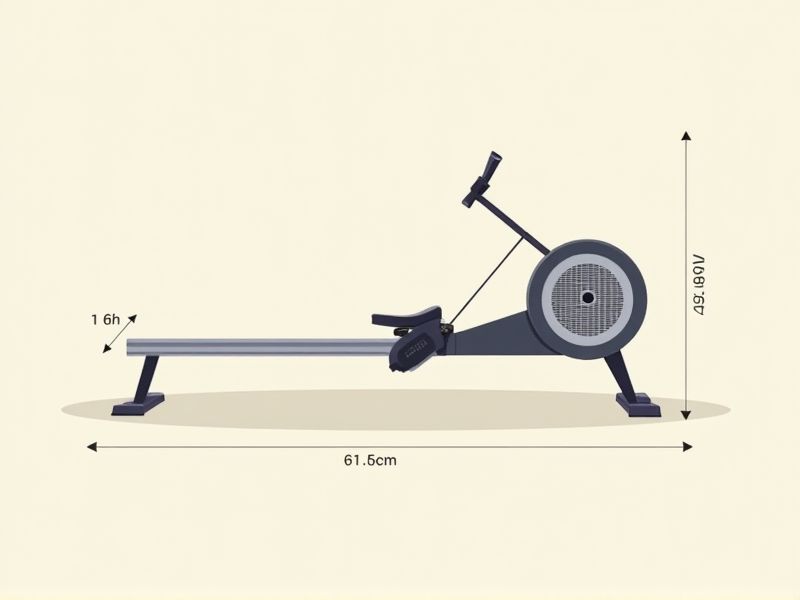
When selecting a rowing machine, it's important to consider the standard dimensions to ensure it fits well within your available space. Most rowing machines are approximately 8 feet (2.4 meters) long and 2 feet (0.6 meters) wide, with a height ranging from 1 to 2 feet (0.3-0.6 meters) depending on the model. For example, the popular Concept2 Model D is about 96 inches (244 cm) long and 24 inches (61 cm) wide. Before purchasing, make sure to measure your designated area and account for extra space needed for comfortable access and movement during your workouts.
Length
The standard rowing machine emphasizes a stroke length of approximately 1.2 to 1.5 meters for optimal performance, ensuring that you engage a full range of motion. This length allows for effective recruitment of major muscle groups, including the legs, back, and arms, facilitating a calorie burn of around 600 calories per hour at moderate intensity. Proper technique involves extending your legs completely while maintaining a straight posture, which can significantly enhance your overall workout efficiency. Regular use of a rowing machine for at least 20 minutes daily can improve cardiovascular health and increase muscular endurance over time.
Width
The standard width of a rowing machine typically ranges from 20 to 25 inches, providing adequate stability during workouts. A wider base enhances balance and allows for a more natural rowing motion, catering to users of all sizes. For optimal performance, consider selecting a model with adjustable footrests, which should accommodate various foot sizes and enhance comfort. Your choice in rowing machine width can significantly influence your exercise experience, making it essential to find a model that suits your needs.
Height
When selecting a rowing machine, height plays a crucial role in ensuring your workout is both comfortable and effective. Most rowing machines have a seat height ranging from 12 to 20 inches, accommodating users between 4'9" and 6'5". For optimal ergonomics, the machine should allow you to achieve a complete rowing stroke without straining your back or legs. As a guideline, your knees should be lower than your hips when seated to maintain proper posture and maximize your workout efficiency.
Seat Height
The seat height of a rowing machine is typically around 12 to 15 inches, allowing users to achieve comfortable positioning during workouts. An optimal seat height ensures that your knees are aligned with the hips, facilitating smooth and efficient movements. Adjustable seat heights are available in many models, catering to a wide range of user heights, from 5 feet to over 6 feet tall. This feature not only enhances comfort but also minimizes the risk of injury and improves overall performance during rowing exercises.
Slide Rail Length
The slide rail length of a rowing machine significantly impacts your indoor rowing experience, with optimal lengths ranging from 42 to 56 inches. A longer slide rail enables users of varying heights to achieve a full range of motion, promoting better form and technique. For individuals over 6 feet tall, a machine with a rail length exceeding 50 inches is recommended to ensure comfort during workouts. Selecting the right slide rail length not only enhances performance but also minimizes the risk of injury by allowing for a more natural rowing stroke.
Footprint Area
A rowing machine typically occupies a footprint area ranging from 7 to 9 square feet, depending on the model. When considering space in your home gym, it's crucial to account for an additional 2 feet of clearance around the machine for safety and proper movement. Compact designs, such as foldable rowing machines, can reduce storage demands while maintaining performance. Investing in a model with a small footprint can maximize your workout space without sacrificing functionality.
Footplate Size
Footplate size on a rowing machine significantly influences your workout efficiency and comfort. An optimal footplate typically measures between 12 to 16 inches in width, allowing for proper foot placement and support during each stroke. Adjustable straps or clips ensure a secure fit, preventing foot slippage and promoting stability, which is essential for maximum power output. By selecting a machine with the right footplate size, you enhance your rowing experience and can achieve better performance outcomes.
Handle Length
The handle length on a rowing machine typically ranges from 19 to 22 inches, designed to accommodate various user heights and enhance comfort during workouts. A longer handle can promote a more extended pull, improving overall stroke efficiency, while a shorter handle may allow for faster transitions and a quicker stroke rate. You should consider that ergonomic handle design can significantly reduce the risk of wrist strain during prolonged use. Ensuring an optimal handle length not only aids performance but also fosters a more enjoyable rowing experience.
Display Screen Size
The display screen size of a rowing machine significantly impacts your workout experience, with optimal sizes ranging from 5 to 10 inches. A larger display can enhance visibility, allowing you to easily track metrics such as distance, time, and calories burned during a session. Many advanced models feature high-definition screens that support real-time feedback and interactive workouts, which can improve motivation and engagement. When selecting a rowing machine, consider your preferences for screen size to ensure a user-friendly interface that aligns with your fitness goals.
Weight Capacity
The weight capacity of a rowing machine typically ranges from 250 to 500 pounds, making it essential to choose a model that accommodates your individual needs. Most commercial-grade rowing machines can support higher weight limits, offering enhanced durability and stability during intense workouts. If your weight exceeds the standard range, consider specialized models designed for heavier users, often featuring reinforced frames and upgraded components. Always check the manufacturer's specifications to ensure that the rowing machine you select will safely support your weight, optimizing your workout experience.
